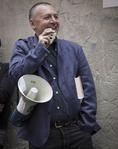Communication tools and techniques special news premio tesi di laurea landscapes history premio letteratura urbanistica composition ecological networks social housing outskirts & suburbs premi tesi di dottorato networks conferences democrazia social capital public art cities urban policies governance conservation & preservation urban africa European policies progetto urbano sustainability
Nomicosecittà Milano Pallottole e Paillettes / Bullets and Sequins
19th May 2012, h.10.30 | Via Malpighi 3
Piero Colaprico, journalist and writer
With Piero Colaprico we have organised a walk along Corso Buenos Aires: “ We could call it also a 'trip through time' because we can both talk about the past and the future. Because, really, if you look at Corso Buenos Aires you look at Italy in 5 years. You see all the races, all the faces, all the twitches, all the trends...”.
The appointment is in via Malpighi 3, right at the entrance of Casa Galimberti, a beautiful liberty building with painted majolica and partly veiled female bodies created at the end of the XIX century. The registered participants to the first walk come closer with curiosity, while some people walking by stop wondering who this strange character is and what he wants to tell.
Piero starts with a writing by Giorgio Bocca describing the atmosphere of the area in the Seventies between the streets, the cafès, the restaurants: exceptional locations hosting – conscious but resigned – the cream of the Milanese underworld. Piero tells us about Transatlantico, the pizza restaurant owned by Rosy and Gabriele, Accademia del Biliardo, etc. recurring names on the crime news pages in those years. Underworld and vita bella, lights and shadows that emerge in the words of Pierfrancesco Sacerdoti (architect and tourist guide), who tells us some anecdotes of a former one-night hotel in via Melzo. We have the last taste of this period through the notes of the song Corso Buenos Aires by Lucio Dalla (1977), in which he tells of a “terrone, a dog and a child who steal some tuna, a salami and a banana stirring up the anger of the people”.
This anecdote allows us to jump 30 years after and Piero reads the story of a migrant who currently lives between Corso Buenos Aires and Via Padova.
The walkers are amused while listening, then Piero goes on and tells about the clashes in 2006 in Corso Buenos Aires, at the corner with viale Regina Giovanna, in a surreal location – the shopping street – under the blank, unbelieving as well as casual gaze of the Milanese busy with the shopping. The journalists were there as well, ready to record what was happening without being able to give a meaning to that profound gap occurring between different populations.
The next stop is in the lazzaretto (i.e. lazaret), a neighborhood with a high presence of immigrants, where we meet Guido from the Libreria Popolare di via Tadino, a space opened in 1974 in front of the CISL building, bulwark of the catholic culture in that period and which has been recently renovated and opened to the public to host readings and seminars. At the bookshop we meet Manuel Ferreira and Elena Lolli from the theatre group Alma Rosè and Elena plays a piece from the Mapu Terra show, giving us an “intimate” gaze on the life of this part of the city, on the turnover of inhabitants under the push of gentrification, on the mixture between cultures and lives.
We come close to the orthodox church of via San Gregorio and then we go back to Corso Buenos Aires where Piero closes the circle in one of the commercial courts before Piazza Argentina, telling us the latest stories of “bullets and sequins” taken from his book “Le cene eleganti”, in which he describes in form of a novel the case of Ruby-heartbreaker who used to work in Corso Buenos Aires and from which come many of the phone tappings that made the case popular. Once again lights and shadows, again Corso Buenos Aires as emblematic space of an Italy that does (not) change.
Piero thanks us and takes us then to the Elfo Puccini theatre, where Elio De Capitani welcomes us.
Elio de Capitani tells us the challenge of his acting company, which has become a social enterprise and is trying to bring back the Culture to one of the most important commercial axes of Europe (it is the second after Oxford Street).
It is late and we need to suddenly leave Elio (“you could not have done anything different”, he tells us) because we have to meet Angelo (AIAB) for lunch at “Il Papavero”, the first biologic resaturant opened in Milan. Here, between biological rissoles and wine without phosphate we end our itinerary, enriched by unique words and emotions.
Piero Colaprico, (1957) lives in Milan, where he deals with justice and crime news as a journalist. He is correspondent for the newspaper La Repubblica. He wrote together with Piero Valpreda the first three books of the series in which the warrant officer Binda is the main character: “Quattro gocce di acqua piovana”, “La nevicata dell'85” and “La primavera dei maimorti”. The series proceeds with “L'estate del Mundial” and “La quinta stagione”, written only by Colaprico after the death of Valpreda. In 2004 “La Trilogia della città di M.” was published: it is a novel composed of three long tales set in Milan in which the main character is inspector Bagni. The book has been awarded with Premio Scerbanenco, ex aequo with “Sorelle” by Barbara Garlaschelli.




Planum
The Journal of Urbanism
ISSN 1723-0993
owned by
Istituto Nazionale di Urbanistica
published by
Planum Association
ISSN 1723-0993 | Registered at Court of Rome 4/12/2001, num. 514/2001
Web site realized by ChannelWeb & Planum Association | Powered by BEdita 3













